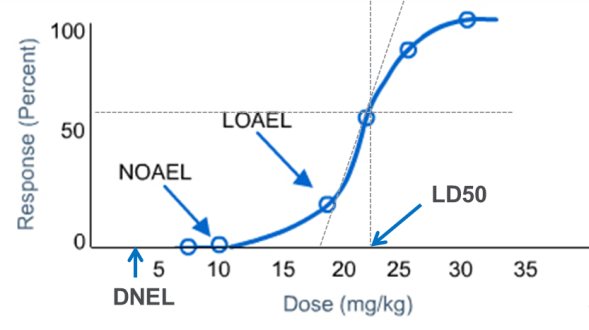Definition of Toxicological Dose Descriptors (LD50, LC50, EC50, NOAEL, LOAEL, etc)
Little Pro on 2016-06-17
In toxicology and eco-toxicology, dose descriptor is the term used to identify the relationship between a specific effect of a chemical substance and the dose at which it takes place. The dose descriptors will be used later for deriving the no-effect threshold levels for human health (i.e, DNEL or reference dose RfD) and the environment (PNEC). Dose descriptors are determined in the toxicological studies on the hazards of the substance and are usually expressed as LC50, LD50, NOAEL, NOAEC, T25, BMD, EC50, NOEC, DT50, etc. They are used for GHS hazard classification and risk assessment. In this article, we will summarize the definition of common toxicology dose descriptors, how they are obtained and what the units are.
LD50 and LC50
LD50 (Lethal Dose 50%) is a statistically derived dose at which 50% of the animals will be expected to die. For inhalation toxicity, air concentrations are used for exposure values. Thus, the LC50 (Lethal Concentration 50%) is used.
LD50 and LC50 are typically obtained from acute toxicity studies.The units of LD50 and LC50 are listed as follows:
- LD50: mg/kg bw. mg/kg bw/d stands for mg of substance per kg of body weight administered per day.
- LC50:mg/L. mg/L is the estimated air concentration of a substance administered via inhalation route. Sometimes, ppm is used.
Lower LD50/LC50 value indicates higher acute toxicity.
NOAEL
No Observed Adverse Effect Level (NOAEL) is the highest exposure level at which there are no biologically significant increases in the frequency or severity of adverse effect between the exposed population and its appropriate control; some effects may be produced at this level, but they are not considered adverse effects.
NOAEL are typically obtained from repeated dose toxicity studies (28d repeated dose toxicity study, 90d repeated dose toxicity study or chronic toxicity) and reproductive toxicity studies. NOAELs are very important. They are used to derive threshold safety exposure dose to humans such as derived no-effect level (DNEL), occupational exposure limit (OEL) and acceptable daily intake (ADI).
The units of NOAEL are mg/kg bw/day or ppm for dermal and oral route. For inthalation route, NOAEC is used instead. The unit can be mg/L/6h/day.
Higher NOAEL or NOAEC indicates lower systemic toxicity or lower chronic toxicity.
LOAEL
Lowest Observed Adverse Effect Level (LOAEL) is the lowest exposure level at which there are biologically significant increases in frequency or severity of adverse effects between the exposed population and its appropriate control group.
Sometimes, only LOAEL can be obtained from repeated dose toxicity studies (28d repeated dose toxicity study, 90d repeated dose toxicity study or chronic toxicity) and reproductive toxicity studies due to study design. If NOAELs cannot be identified, LOAEL are also used to derive threshold safety exposure dose to humans such as derived no effect level (DNEL). However, higher assessment factors need to be applied.
The picture below shows you the relationship between LD50, LOAEL, NOAEL and DNEL on a typical dose-response curve.

T25 and BMD10
It is generally recognized that some chemicals (non-threshold carcinogens) will cause carcinogenic risks even at the smallest exposure concentration. For many carcinogenicity studies, the conventional NOAEL cannot be identified for risk assesment. Thus T25 and BMD10 are used.
- T25: the chronic dose rate that will give 25% of the animals’ tumors at a specific tissue after correction for spontaneous incidence, within the life time of that species.
- BMD10: derived bench mark dose assumed to give 10% of the animals’ tumors at a specific tissue after correction for spontaneous incidence, within the life time of that species.
The units of T25 and BMD10 are mg/kg bw/day or ppm. They can be used to calculate derived minimal effect level (DMEL) - a level of exposure below which the risk levels of carcinogen become tolerable.
EC50
In ecotoxicity, EC50 (median effective concentration) is the concentration of test substance which results in a 50 percent reduction in either algae growth (EbC50) or algae growth rate (ErC50) or Daphina immobilization.They are often obtained from acute aquatic oxicity studies.
The units of EC50 are mg/L. EC50 values are often used for acute enviromental hazard classification and calculation of predicted non-effect concentration (PNEC).
Read more: How to Use EbC50, ErC50, ErC10 and NOEC Data
NOEC
No observed effect concentration (NOEC) is the concentration in an environmental compartment (water, soil, etc) which below an unacceptable effect is unlikely to be observed. It is typically obtained from chronic aquatic toxicity studies and terrestrial toxicity studies.
The units of NOEC are mg/L. NOEC values are often used for chronic enviromental hazard classification and calculation of predicted non-effect concentration (PNEC).
DT50
Half-life (DT50) is defined as the time it takes for an amount of a compound to be reduced by half through degradation in an environmental compartment (water, soil, air, etc). It is used to measure the persistence of a substance.
The unit is day. DT50 is often used in environmental exposure modelling to predict the concentration of a substance in an environmental compartment over a long time of period.
Having Questions?
We do not provide consultancy services. If you have questions or need any help, please contact our sponsor. You may also find an expert in CSP business directory below. If you are a consultant, you may get yourself listed in CSP business directory (free) or sponsor this page to leave your contact info on this page..
